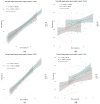Prediction of Whole Liver Graft Weight Based on Biometric Variables in Paediatric and Adult Liver Donors
- PMID: 39457213
- PMCID: PMC11506035
- DOI: 10.3390/children11101248
Prediction of Whole Liver Graft Weight Based on Biometric Variables in Paediatric and Adult Liver Donors
Abstract
Background/objectives: In paediatric liver transplantation, donor-recipient compatibility depends on graft size. We explored whether the graft weight can be predicted using the donor's biometric parameters.
Methods: We used seven easily available biometric variables in 142 anonymised paediatric and adult donors, with data collected between 2016 and 2022. The whole or partial liver was transplanted in our hospital from these donors. We identified the variables that had the strongest correlation to our response variable: whole liver graft weight.
Results: In child donors, we determined two linear models: using donor weight and height on the one hand and using donor weight and right liver span on the other hand. Both models had a coefficient of determination R2 = 0.86 and p-value < 10-5. We also determined two models in adult donors using donor weight and height (R2 = 0.33, p < 10-4) and donor weight and sternal height (R2 = 0.38, p < 10-4). The models proved valid based on our external dataset of 245 patients from two institutions.
Conclusions: In clinical practise, our models could provide rapidly accessible estimates to determine whole graft dimension compatibility in liver transplantation in children and adults. Determining similar models predicting the left lobe and lateral segment weight could prove invaluable in paediatric transplantation.
Keywords: linear regression; liver transplantation; model.
Conflict of interest statement
The authors declare no conflicts of interest. The funders had no role in the design of the study; in the collection, analyses, or interpretation of data; in the writing of the manuscript; or in the decision to publish the results.
Figures




References
-
- Yang X., Park S., Lee S., Han K., Lee M.R., Song J.S., Yu H.C., Do Yang J. Estimation of right lobe graft weight for living donor liver transplantation using deep learning-based fully automatic computed tomographic volumetry. Sci. Rep. 2023;13:17746. doi: 10.1038/s41598-023-45140-0. - DOI - PMC - PubMed
LinkOut - more resources
Full Text Sources

